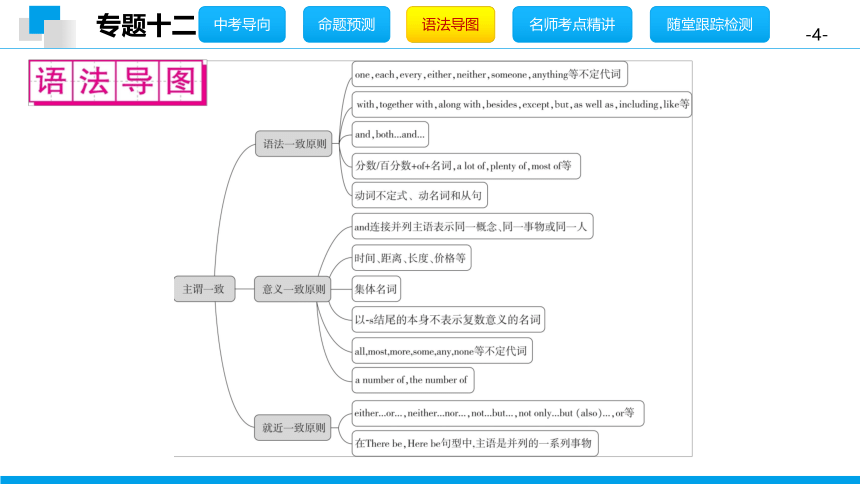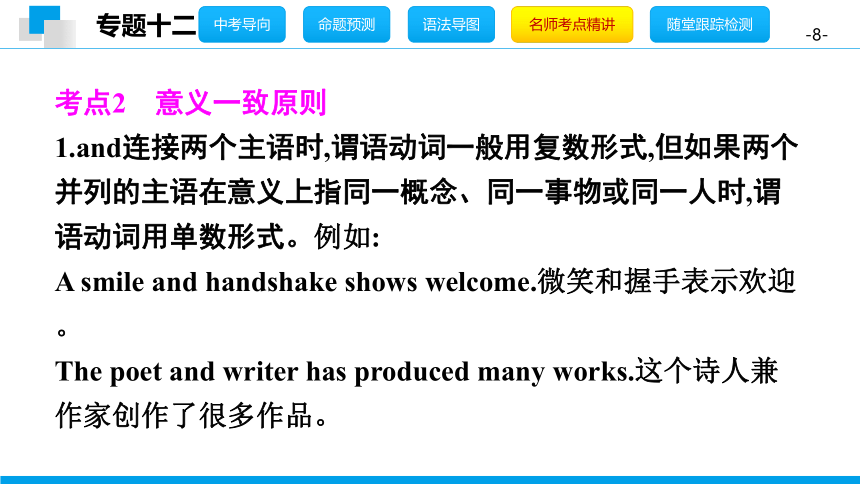2021年安徽省中考英语语法专题突破十二——主谓一致 课件(共20张PPT)
文档属性
| 名称 | 2021年安徽省中考英语语法专题突破十二——主谓一致 课件(共20张PPT) |  | |
| 格式 | zip | ||
| 文件大小 | 1.2MB | ||
| 资源类型 | 教案 | ||
| 版本资源 | 通用版 | ||
| 科目 | 英语 | ||
| 更新时间 | 2021-01-04 21:04:12 | ||
图片预览









文档简介
(共20张PPT)
专题十二 主谓一致
主谓一致的三个基本原则,即语法一致原则、意义一致原则和就近一致原则。
近年来安徽中考并未直接考查过主谓一致这一语法点,但主谓一致在单词拼写、书面表达等题型中常有涉及,所以复习时应了解这一语法点,提高相关题型的得分率。
考点1 语法一致原则
主语和谓语通常在语法形式上保持一致,即主语是单数形式时,谓语动词也采用单数形式;主语是复数形式时,谓语动词也采用复数形式。
1.不定代词one,
each,
every,
either,
neither等以及由some?,
any?,
no?,
every?等构成的复合不定代词作主语时,谓语动词用单数形式。例如:
Each
of
us
has
an
English
book.我们每个人都有一本英语书。
Is
everybody
ready?每个人都准备好了吗?
2.主语后有with,
together
with,
along
with,
besides,
except,
but,
as
well
as,
including,
like等词时,谓语动词与它前面的主语在人称和数上保持一致。例如:
The
teacher
with
his
students
is
going
to
visit
the
museum.老师和他的学生们将去参观博物馆。
3.由and或both...and...连接的并列成分作主语时,谓语动词用复数形式。例如:
Both
he
and
I
are
right.我和他都是对的。
4.“分数或百分数+of+名词”以及“a
lot
of/lots
of/plenty
of/half
of/the
rest
of/(a)
part
of+名词”构成的短语作主语时,其谓语动词形式要以of后面的名词而定。名词是复数时,谓语动词用复数形式;名词是单数时,谓语动词用单数形式。例如:
Lots
of
damage
is
caused
by
fire.很多损失是由火灾造成的。
5.动词不定式、动名词或从句作主语时,谓语动词用单数形式。例如:
Doing
morning
exercise
is
good
for
your
health.晨练有益健康。
考点2 意义一致原则
1.and连接两个主语时,谓语动词一般用复数形式,但如果两个并列的主语在意义上指同一概念、同一事物或同一人时,谓语动词用单数形式。例如:
A
smile
and
handshake
shows
welcome.微笑和握手表示欢迎。
The
poet
and
writer
has
produced
many
works.这个诗人兼作家创作了很多作品。
2.表时间、距离、长度、价格、度量的词或短语作主语时,一般被看作一个整体,谓语动词用单数形式。例如:
Fifty
dollars
is
enough.50美元足够了。
3.有些集体名词(如family,
class,
team
等)作主语时,若看作整体概念,谓语动词用单数形式;若强调其中的每个成员,谓语动词用复数形式。例如:
Mr.
Smith’s
family
is
a
big
one.史密斯先生家是一个大家庭。
Mr.
Smith’s
family
are
watching
TV.史密斯一家人正在看电视。
4.有些集体名词形式上虽为单数,但意义上为复数(如people,
police,
cattle,
sheep等),作主语时,谓语动词用复数形式。例如:
A
lot
of
people
are
dancing
outside.很多人正在外面跳舞。
The
police
are
looking
for
the
lost
boy.警察正在找那个丢失的男孩。
5.以?s结尾的本身不表示复数意义的名词,如politics,
physics,
the
United
States,
news,
maths
等,作主语时,谓语动词用单数形式。例如:
The
news
is
very
exciting.那则新闻真令人兴奋。
Physics
is
a
bit
difficult
for
me.物理对我来说有点难。
6.all,
most,
more,
some,
any,
none等不定代词作主语时,若指代可数名词复数,谓语动词用复数形式;若指代可数名词单数或不可数名词,谓语动词用单数形式。(其中none作主语时,若指代可数名词,谓语动词用单复数皆可。)例如:
Now
all
has
been
changed.现在一切都变了。
All
are
present.所有的都在这里。
7.“a
number
of+名词复数”表示“许多……”,作主语时,谓语动词用复数形式;“the
number
of+名词复数”表示“……的数量”,作主语时,谓语动词用单数形式。例如:
The
number
of
the
boys
in
our
class
is
28.我们班男生的人数是28。
A
number
of
players
are
from
America.很多队员来自美国。
考点3 就近一致原则
就近一致原则就是谓语动词的单、复数形式取决于最靠近它的主语的单、复数。
1.由either...or,
neither...nor,
not...but...,not
only...but
(also)...,
or等连接并列的主语时,谓语动词应与最靠近它的主语在人称和数上保持一致。例如:
Neither
her
parents
nor
she
herself
is
a
bank
clerk.她父母和她本人都不是银行职员。
Either
my
father
or
my
mother
makes
meals
on
weekdays.在工作日,不是我爸爸就是我妈妈做饭。
2.当There
be和Here
be句型中的主语是一系列事物时,谓语动词应与离其最近的主语在人称和数上保持一致。例如:
Here
is
a
pen,
a
knife
and
several
books
for
you.这是给你的一支钢笔、一把小刀和几本书。
There
are
twenty
boys
and
twenty?three
girls
in
the
classroom.教室里有20名男生和23名女生。
单项填空
1.—Some
of
the
coins
in
my
box
missing.?
—Why?
Some
of
the
money
in
my
desk
missing,
too.
(
C
)?
A.is;is
B.is;are
C.are;is
D.are;are
2.—Do
you
need
more
time
to
complete
the
task?
—Yes.
Another
ten
days enough.(
A
)?
A.is
B.was
C.are
D.were
3.—Neither
Tony
nor
I interested
in
playing
WeChat.?
—You
are
out.(
A
)
A.am
B.is
C.are
D.be
4.The
zoo
keeper
is
worried
because
the
number
of
visitors smaller
and
smaller.(
C
)?
A.become
B.are
becoming
C.is
becoming
D.have
become
5.—Good
news!
Nearly
three
fourths
of
the
work
.?
—Great!
Maybe
we
can
have
a
trip
soon.(
D
)
A.have
finished
B.has
finished
C.have
been
finished
D.has
been
finished
6.I
have
finished
a
large
part
of
the
book;
the
rest
more
difficult.(
A
)?
A.is
B.are
C.was
D.were
7.There lots
of
sheep
and
pigs
on
my
uncle’s
farm
now.(
D
)?
A.was
B.were
C.is
D.are
8.To
go
to
bed
early
and
to
rise
early a
good
habit.
(
B
)?
A.are
B.is
C.was
D.were
9.Everybody
except
Mike
and
Linda there
when
the
meeting
began.(
C
)?
A.is
B.are
C.was
D.were
10.The
head
teacher
and
Chinese
teacher
giving
a
speech
while
the
rest
of
the
class
listening
carefully.
(
D
)?
A.were;were
B.was;was
C.were;was
D.was;were
专题十二 主谓一致
主谓一致的三个基本原则,即语法一致原则、意义一致原则和就近一致原则。
近年来安徽中考并未直接考查过主谓一致这一语法点,但主谓一致在单词拼写、书面表达等题型中常有涉及,所以复习时应了解这一语法点,提高相关题型的得分率。
考点1 语法一致原则
主语和谓语通常在语法形式上保持一致,即主语是单数形式时,谓语动词也采用单数形式;主语是复数形式时,谓语动词也采用复数形式。
1.不定代词one,
each,
every,
either,
neither等以及由some?,
any?,
no?,
every?等构成的复合不定代词作主语时,谓语动词用单数形式。例如:
Each
of
us
has
an
English
book.我们每个人都有一本英语书。
Is
everybody
ready?每个人都准备好了吗?
2.主语后有with,
together
with,
along
with,
besides,
except,
but,
as
well
as,
including,
like等词时,谓语动词与它前面的主语在人称和数上保持一致。例如:
The
teacher
with
his
students
is
going
to
visit
the
museum.老师和他的学生们将去参观博物馆。
3.由and或both...and...连接的并列成分作主语时,谓语动词用复数形式。例如:
Both
he
and
I
are
right.我和他都是对的。
4.“分数或百分数+of+名词”以及“a
lot
of/lots
of/plenty
of/half
of/the
rest
of/(a)
part
of+名词”构成的短语作主语时,其谓语动词形式要以of后面的名词而定。名词是复数时,谓语动词用复数形式;名词是单数时,谓语动词用单数形式。例如:
Lots
of
damage
is
caused
by
fire.很多损失是由火灾造成的。
5.动词不定式、动名词或从句作主语时,谓语动词用单数形式。例如:
Doing
morning
exercise
is
good
for
your
health.晨练有益健康。
考点2 意义一致原则
1.and连接两个主语时,谓语动词一般用复数形式,但如果两个并列的主语在意义上指同一概念、同一事物或同一人时,谓语动词用单数形式。例如:
A
smile
and
handshake
shows
welcome.微笑和握手表示欢迎。
The
poet
and
writer
has
produced
many
works.这个诗人兼作家创作了很多作品。
2.表时间、距离、长度、价格、度量的词或短语作主语时,一般被看作一个整体,谓语动词用单数形式。例如:
Fifty
dollars
is
enough.50美元足够了。
3.有些集体名词(如family,
class,
team
等)作主语时,若看作整体概念,谓语动词用单数形式;若强调其中的每个成员,谓语动词用复数形式。例如:
Mr.
Smith’s
family
is
a
big
one.史密斯先生家是一个大家庭。
Mr.
Smith’s
family
are
watching
TV.史密斯一家人正在看电视。
4.有些集体名词形式上虽为单数,但意义上为复数(如people,
police,
cattle,
sheep等),作主语时,谓语动词用复数形式。例如:
A
lot
of
people
are
dancing
outside.很多人正在外面跳舞。
The
police
are
looking
for
the
lost
boy.警察正在找那个丢失的男孩。
5.以?s结尾的本身不表示复数意义的名词,如politics,
physics,
the
United
States,
news,
maths
等,作主语时,谓语动词用单数形式。例如:
The
news
is
very
exciting.那则新闻真令人兴奋。
Physics
is
a
bit
difficult
for
me.物理对我来说有点难。
6.all,
most,
more,
some,
any,
none等不定代词作主语时,若指代可数名词复数,谓语动词用复数形式;若指代可数名词单数或不可数名词,谓语动词用单数形式。(其中none作主语时,若指代可数名词,谓语动词用单复数皆可。)例如:
Now
all
has
been
changed.现在一切都变了。
All
are
present.所有的都在这里。
7.“a
number
of+名词复数”表示“许多……”,作主语时,谓语动词用复数形式;“the
number
of+名词复数”表示“……的数量”,作主语时,谓语动词用单数形式。例如:
The
number
of
the
boys
in
our
class
is
28.我们班男生的人数是28。
A
number
of
players
are
from
America.很多队员来自美国。
考点3 就近一致原则
就近一致原则就是谓语动词的单、复数形式取决于最靠近它的主语的单、复数。
1.由either...or,
neither...nor,
not...but...,not
only...but
(also)...,
or等连接并列的主语时,谓语动词应与最靠近它的主语在人称和数上保持一致。例如:
Neither
her
parents
nor
she
herself
is
a
bank
clerk.她父母和她本人都不是银行职员。
Either
my
father
or
my
mother
makes
meals
on
weekdays.在工作日,不是我爸爸就是我妈妈做饭。
2.当There
be和Here
be句型中的主语是一系列事物时,谓语动词应与离其最近的主语在人称和数上保持一致。例如:
Here
is
a
pen,
a
knife
and
several
books
for
you.这是给你的一支钢笔、一把小刀和几本书。
There
are
twenty
boys
and
twenty?three
girls
in
the
classroom.教室里有20名男生和23名女生。
单项填空
1.—Some
of
the
coins
in
my
box
missing.?
—Why?
Some
of
the
money
in
my
desk
missing,
too.
(
C
)?
A.is;is
B.is;are
C.are;is
D.are;are
2.—Do
you
need
more
time
to
complete
the
task?
—Yes.
Another
ten
days enough.(
A
)?
A.is
B.was
C.are
D.were
3.—Neither
Tony
nor
I interested
in
playing
WeChat.?
—You
are
out.(
A
)
A.am
B.is
C.are
D.be
4.The
zoo
keeper
is
worried
because
the
number
of
visitors smaller
and
smaller.(
C
)?
A.become
B.are
becoming
C.is
becoming
D.have
become
5.—Good
news!
Nearly
three
fourths
of
the
work
.?
—Great!
Maybe
we
can
have
a
trip
soon.(
D
)
A.have
finished
B.has
finished
C.have
been
finished
D.has
been
finished
6.I
have
finished
a
large
part
of
the
book;
the
rest
more
difficult.(
A
)?
A.is
B.are
C.was
D.were
7.There lots
of
sheep
and
pigs
on
my
uncle’s
farm
now.(
D
)?
A.was
B.were
C.is
D.are
8.To
go
to
bed
early
and
to
rise
early a
good
habit.
(
B
)?
A.are
B.is
C.was
D.were
9.Everybody
except
Mike
and
Linda there
when
the
meeting
began.(
C
)?
A.is
B.are
C.was
D.were
10.The
head
teacher
and
Chinese
teacher
giving
a
speech
while
the
rest
of
the
class
listening
carefully.
(
D
)?
A.were;were
B.was;was
C.were;was
D.was;were
同课章节目录
- 词法
- 名词
- 动词和动词短语
- 动词语态
- 动词时态
- 助动词和情态动词
- 非谓语动词
- 冠词
- 代词
- 数词和量词
- 形容词副词及其比较等级
- 介词和介词短语
- 连词和感叹词
- 构词法
- 相似、相近词比较
- 句法
- 陈述句
- 一般疑问句和否定疑问句
- 特殊疑问句及选择疑问句
- 反意疑问句
- 存在句(There be句型)
- 宾语从句
- 定语从句
- 状语从句
- 主谓一致问题
- 简单句
- 并列句
- 复合句
- 主谓一致
- 主、表语从句
- 名词性从句
- 直接引语和间接引语
- 虚拟语气
- 感叹句
- 强调句
- 倒装句
- 祈使句
- 句子的成分
- 句子的分类
- 题型专区
- 单项选择部分
- 易错题
- 完形填空
- 阅读理解
- 词汇练习
- 听说训练
- 句型转换
- 补全对话
- 短文改错
- 翻译
- 书面表达
- 任务型阅读
- 语法填空
- 其他资料
